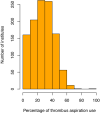Use of Thrombus Aspiration for Patients With Acute Coronary Syndrome: Insights From the Nationwide J-PCI Registry
- PMID: 35946472
- PMCID: PMC9496318
- DOI: 10.1161/JAHA.122.025728
Use of Thrombus Aspiration for Patients With Acute Coronary Syndrome: Insights From the Nationwide J-PCI Registry
Abstract
Background There is significant regional or institutional variation in the use of thrombus aspiration (TA) in patients undergoing percutaneous coronary intervention (PCI). We investigated the temporal trend in TA use and its association with clinical outcomes in acute coronary syndrome using the nationwide J-PCI (Japanese PCI) registry. Methods and Results Between 2016 and 2018, patients with acute coronary syndrome undergoing PCI (n=282 606; median age, 71.0 years; interquartile range, 62.0-79.0 years; women, 24.7%) at 1124 hospitals were stratified on the basis of whether TA was performed (TA and non-TA). The patients were subdivided according to clinical presentation (ST-segment-elevation myocardial infarction, non-ST-segment-elevation myocardial infarction, and unstable angina). Successful PCI, defined as the achievement of TIMI (Thrombolysis in Myocardial Infarction) 3 flow, and in-hospital mortality were assessed. During the study period, 83 422 patients (29.5%) underwent TA (52.9%, 23.5%, and 5.2% for ST-segment-elevation myocardial infarction, non-ST-segment-elevation myocardial infarction, and unstable angina, respectively), and the TA implementation rate remained relatively stable throughout. Patients treated with TA had higher rate of successful PCI than non-TA (98.7% versus 97.8%; P<0.001). TA was not associated with in-hospital death among patients with ST-segment-elevation myocardial infarction (adjusted odds ratio [aOR], 1.02 [95% CI, 0.94-1.12]). However, TA use was associated with higher rates of in-hospital death in patients with non-ST-segment-elevation myocardial infarction ( aOR, 1.51 [95% CI, 1.23-1.86]) or unstable angina ( aOR, 1.95 [95% CI, 1.37-2.79]). Conclusions In our retrospective analysis of the nationwide PCI registry, TA use was associated with a higher achievement of successful PCI without impairing in-hospital mortality among patients with ST-segment-elevation myocardial infarction. Nevertheless, its use should be cautioned in less-established indications (eg, non-ST-segment-elevation myocardial infarction and unstable angina).
Keywords: acute coronary syndrome; myocardial infarction; percutaneous coronary intervention; thrombus aspiration.
Figures





Comment in
-
The State of Coronary Thrombus Aspiration.J Am Heart Assoc. 2022 Aug 16;11(16):e026849. doi: 10.1161/JAHA.122.026849. Epub 2022 Aug 10. J Am Heart Assoc. 2022. PMID: 35946445 Free PMC article. No abstract available.
References
-
- Ibanez B, James S, Agewall S, Antunes MJ, Bucciarelli‐Ducci C, Bueno H, Caforio ALP, Crea F, Goudevenos JA, Halvorsen S, et al. 2017 ESC guidelines for the management of acute myocardial infarction in patients presenting with ST‐segment elevation: the task force for the management of acute myocardial infarction in patients presenting with ST‐segment elevation of the European Society of Cardiology (ESC). Eur Heart J. 2018;39:119–177. doi: 10.1093/eurheartj/ehx393 - DOI - PubMed
-
- Levine GN, Bates ER, Blankenship JC, Bailey SR, Bittl JA, Cercek B, Chambers CE, Ellis SG, Guyton RA, Hollenberg SM, et al. 2015 ACC/AHA/SCAI focused update on primary percutaneous coronary intervention for patients with ST‐elevation myocardial infarction: an update of the 2011 ACCF/AHA/SCAI guideline for percutaneous coronary intervention and the 2013 ACCF/AHA guideline for the management of ST‐elevation myocardial infarction. Circulation. 2016;133:1135–1147. doi: 10.1161/CIR.0000000000000336 - DOI - PubMed
Publication types
MeSH terms
LinkOut - more resources
Full Text Sources
Medical
Miscellaneous

